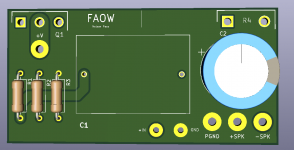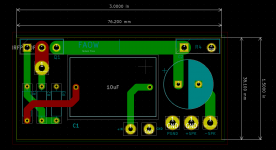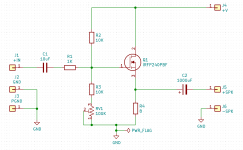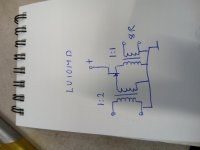Back to the original schematic I am all out of 10k resistors so I was thinking I could just use this self biasing device. Actually this is an interesting device first it's rather cheap at $6 for a 190W part the ciss is rather low at 650pf and it takes a - voltage to turn it off. In the 4 devices I tested with the gate grounded I dropped about 8v across a 8 ohm source resistor and this didn't go up much as I raised the source to drain voltage. https://www.mouser.com/datasheet/2/827/DS_UJ3N065080K3S-1530401.pdf
here's ZM
can' have a gain , being source follower
Not voltage gain, but current gain and power gain aren't to be ignored!
is there gonna be a PCB available for this one? 😀
I don't know what's funnier, seing you here or the question in itself...😛
cause why not?😀 need a decent desktop amp to power my Woden Lance's. Been using a TDA7297. Going to use IRFP240 or 250.
Attachments
In trying to learn a bit more about source followers, playing with the sim and kicad, I added a pot to set the bias. Is the aim to set the S-GND at 1/2 rail? Doing so makes the disspiation more or less equal on the fet and power resistor. Is that ideal? May be time to figure out how to use a O'scope.
Attachments
If you are doing sims, you can vary parameters and check the results for differences. In LTSpice, FFTs can be done for distortion analysis, and AC analysis will give frequency response.
I started playing around with LTSpice this year and it has been very educational. Circuits can be tried without parts, power supplies, or oscilloscopes, etc. The only limiting factor is the accuracy of some of the more exotic components such as SITs.
In your example, you can run it in LTSpice, vary the bias and also vary R4 to see the effects on harmonic distortion. Vary V+ too to see what happens.
Another point - an USB sound card and a program such as REW or ARTA are probably more useful than an oscilloscope for evaluating amplifiers after they are built.
I started playing around with LTSpice this year and it has been very educational. Circuits can be tried without parts, power supplies, or oscilloscopes, etc. The only limiting factor is the accuracy of some of the more exotic components such as SITs.
In your example, you can run it in LTSpice, vary the bias and also vary R4 to see the effects on harmonic distortion. Vary V+ too to see what happens.
Another point - an USB sound card and a program such as REW or ARTA are probably more useful than an oscilloscope for evaluating amplifiers after they are built.
Last edited:
If my budget allowed, I'd be tempted to try the 1H Hammond 193S. You'd need to take B+ up to 15 volts or so.
Hi Michael,
As chance would have it, I just picked up a pair of 193S cheap on ebay. Did you ever try them out in this schematic, or the one from post #101?
Best
Nigel
Last edited:
I remember that circuit. I just couldn't tame the LU1014D in that one. It required really careful selection, and even with that it was pretty wobbly. A cascode of some sort might be the ticket.
Or, some other more agreeable depletion part, perhaps with some voltage feedback to make it more triodey. 🙂
Or, some other more agreeable depletion part, perhaps with some voltage feedback to make it more triodey. 🙂
Thanks, Michael. Could you say a little more about what "wobbly" means here?
I'll have to give it some thought as to what to do. I have some LD1014D I'd like to use so I'll think about the cascode idea. I still have to finish other projects already underway, so there's time...
Best
Nigel
I'll have to give it some thought as to what to do. I have some LD1014D I'd like to use so I'll think about the cascode idea. I still have to finish other projects already underway, so there's time...
Best
Nigel
Bias stability + big variations in sweet spot at those voltages. It's why NP had good success with cascodes.
There may be one more trick available for those, but I just haven't been able to do much experimenting with it lately. 🙂
There may be one more trick available for those, but I just haven't been able to do much experimenting with it lately. 🙂
OK, thanks again. This may be beyond my talents, being mostly a solder slinger, but I'll give it some thought.
Best
Nigel
Best
Nigel
Thanks, Michael. Could you say a little more about what "wobbly" means here?
I'll have to give it some thought as to what to do. I have some LD1014D I'd like to use so I'll think about the cascode idea. I still have to finish other projects already underway, so there's time...
Best
Nigel
LU1014D is very stable in cascode with usual IRFP240. I have driven it as high as 6A but 2A to 3A it’s perfectly happy as a nice source follower.
LuFo Amp - 39w SE Class A from 28v Rail
You could replace the choke load with a resistive load and it sound work fine, albeit lower max power.
Yes, I've been reading the LuFo thread - looks very cool indeed. At 39W it's way bigger than a 1W amp, though. Having said that, just using one IRFP240 would allow for more current than the 193S can handle before saturating, I think, so maybe I can figure something out.
And yes, I suppose I could switch to a resistive load, but part of the fun here is try these big chokes out. Of course I dare say there are other things I might try with them.
Best
Nigel
And yes, I suppose I could switch to a resistive load, but part of the fun here is try these big chokes out. Of course I dare say there are other things I might try with them.
Best
Nigel
You don’t have to run the Lu1014d at such a high current. I have used it in headphone amps around 120mA. An IRF610 could be used for the cascode on a smaller scale.
To the extent I have thought this through at all (which isn't very much, at this point) I was thinking of running at about 0.5A, because the 193S is rated at 1A, so I was guesstimating that about 0.5A would be about as much as it could handle without saturating.
I know what you mean about the LU1014D and headphones. I built Patrick's DAO amp a few years ago, which sounds just great. In fact, it's because of that and my recent F3 build (which I am also v. happy with) that I am keen to play more with the Lovoltech jfets.
Best
Nigel
I know what you mean about the LU1014D and headphones. I built Patrick's DAO amp a few years ago, which sounds just great. In fact, it's because of that and my recent F3 build (which I am also v. happy with) that I am keen to play more with the Lovoltech jfets.
Best
Nigel
very late to the party but i realised you can feed it up to 7V (and more but the power draw almost doubles)It's a slow day. Time for a little entertainment - a micro project!
Someone sent me a request for a simple 1 watt amplifier.
How could I resist?
My answer:
Assuming that your preamp can put out 2 volts (and it should),
a 1 watt design would be the easiest thing in the world.
Attached is an example.
I will put it up on the Pass Labs forum at diyaudio and see
what kind of suggestions it gets for construction and improvement.
Feel free to post questions.
"Zen Mod" will likely be the first to take the bait.
The following draws 1.5A off a 19V computer desktop supply and gets
1 watt into 8 ohms at about .5% THD.

Find the transformer challange *impossible or expensiveHow about a three parts amplifier?
- Home
- Amplifiers
- Pass Labs
- FAOW




